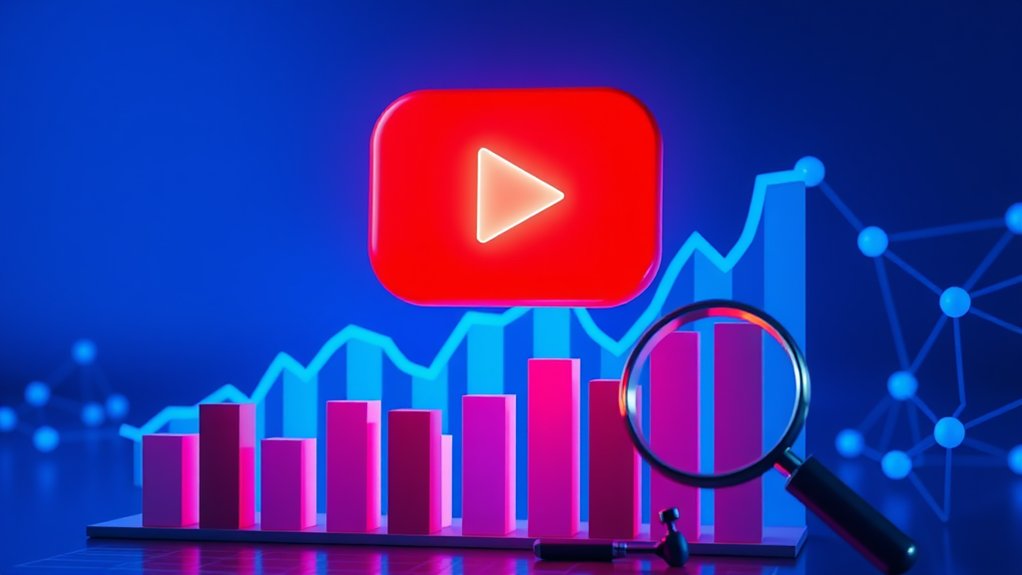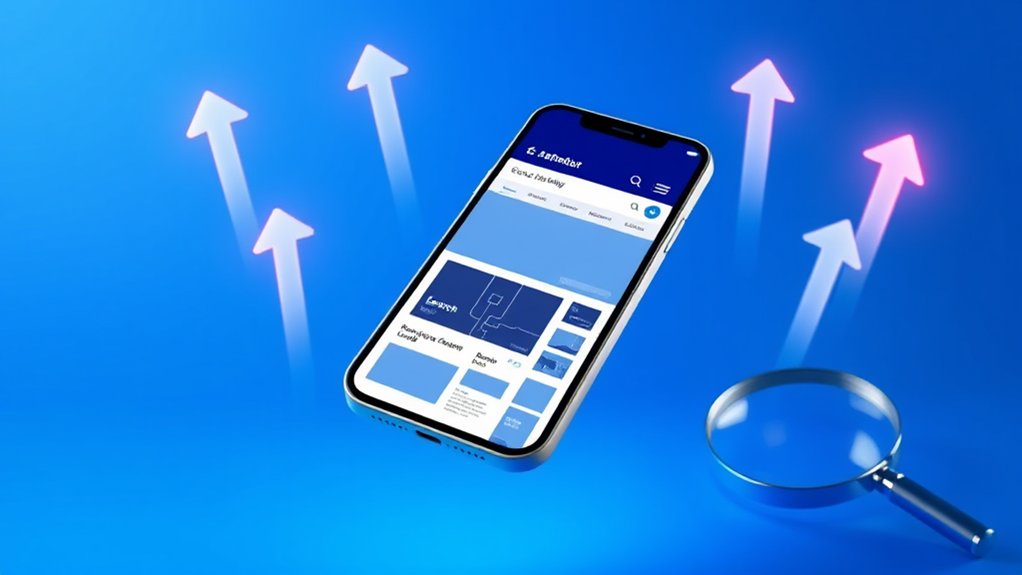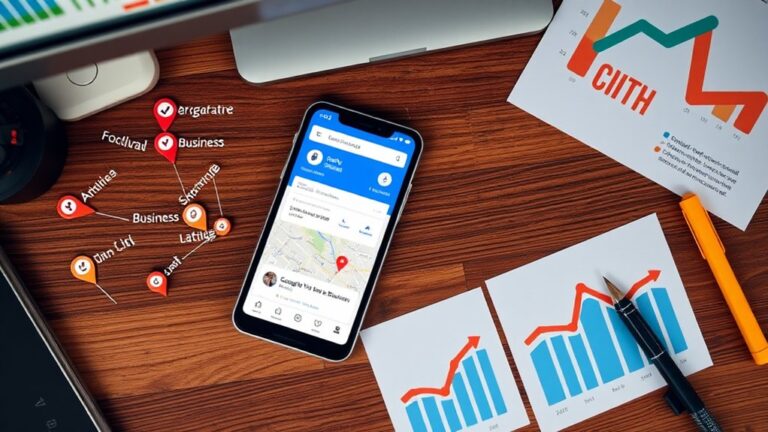SEO can greatly boost your online visibility by strategically positioning your website in search engine rankings. You'll need to focus on quality content creation, mobile optimization, and targeted keyword research to attract potential customers actively searching for your products or services. By implementing effective SEO strategies, including local SEO optimization and maintaining a strong technical foundation, you'll improve your site's chances of appearing in top search results. A well-structured SEO approach also involves optimizing user experience, ensuring fast loading times, and building authoritative backlinks. Understanding these fundamental elements will reveal your website's full potential in the digital marketplace.
Understanding Search Engine Rankings

Search engines operate like digital librarians, carefully evaluating and ranking websites based on numerous factors. When you understand how search engine algorithms work, you'll be better equipped to optimize your website for higher rankings.
The key ranking factors include content quality, backlinks, and technical aspects of your site. Regular content updates help maintain freshness and improve your site's performance in search results.
To improve your visibility, you'll need to focus on creating high-quality, relevant content that matches user intent. Search engine algorithms also consider your website's technical performance, including page speed and mobile-friendliness.
You'll want to ascertain your site is secure, accessible, and properly structured with internal links. Additionally, building a strong brand presence and earning quality backlinks from reputable sources will substantially impact your rankings.
Remember that user experience plays an essential role, so keep your site navigation intuitive and engaging.
Keyword Research Fundamentals
While many aspects of SEO can seem complex, keyword research forms the foundation of any successful digital marketing strategy. To excel at keyword research techniques, you'll need to focus on content topic identification and search intent alignment, ensuring that your content matches what users are actually looking for online.
A combination of head and long-tail keywords provides the most comprehensive targeting approach for maximum search visibility. Additionally, understanding audience search behavior is essential for tailoring your content effectively.
Start by using reliable keyword analysis tools like Moz, SEMrush, or Ahrefs to find high volume keywords that align with your business goals.
During your keyword difficulty assessment, you'll want to balance competitiveness with opportunity, often focusing on long tail strategies that target specific niches.
Your competitive keyword analysis should include examining what's working for others in your industry while identifying gaps you can fill.
Remember to prioritize topics that serve your audience's needs, not just search engines.
Content Quality Matters

As digital marketing evolves, content quality has become the cornerstone of successful SEO strategies. Your content strategies must focus on audience engagement while staying current with SEO trends.
You'll need to incorporate multimedia usage effectively and maintain a strong readability focus to keep visitors on your pages longer.
To build authority and attract valuable backlinks, you'll want to implement robust backlink strategies and consistently gather user feedback to refine your approach.
Regular content updates are essential to keep your material fresh and relevant, while optimization techniques help guarantee your content performs well in search results. Additionally, understanding keyword intent is crucial for driving targeted traffic and improving search rankings.
Mobile-First SEO Approach
You'll need to embrace responsive design as your foundation for mobile-first SEO, ensuring your website automatically adjusts to fit any screen size perfectly.
Your success depends heavily on implementing speed optimization tactics, such as compressing images and minimizing code, which directly impact your mobile search rankings.
When structuring your mobile content, you'll want to focus on clear headings, short paragraphs, and easily clickable elements that enhance the user experience on smaller screens. Additionally, understanding mobile user behavior is crucial for optimizing your local search strategies effectively.
Responsive Design Fundamentals
Since mobile devices now dominate web traffic, responsive design has become essential for SEO success. You'll need to implement responsive design techniques that guarantee your website adapts seamlessly to different screen sizes and devices. This includes using flexible grids, fluid images, and CSS media queries to create a consistent user experience across all platforms.
Start by focusing on mobile usability testing to verify that your content remains accessible and engaging on smartphones and tablets. You'll want to prioritize essential content for mobile users while maintaining quick loading times through image optimization and lazy loading.
Remember to use percentage-based measurements for widths and heights, guaranteeing your layout scales properly. This approach aligns perfectly with Google's mobile-first indexing, helping you maintain strong search rankings and visibility. Additionally, optimizing your site for mobile user experience is crucial as Google prioritizes it in rankings.
Speed Optimization Tactics
While mobile users demand instant access to information, page speed has become a crucial factor in both SEO rankings and user experience.
To optimize your site's performance, you'll need to focus on several key strategies. Start with image compression techniques to reduce file sizes without compromising quality, and implement browser caching strategies to minimize reload times.
CDN utilization benefits include faster content delivery across different geographical locations, while AMP implementation tips can help create lightning-fast mobile pages.
Focus on efficient coding practices and server response optimization to enhance overall performance. Optimizing your Google My Business profile can also contribute to improved visibility and search performance.
Don't forget redirect management strategies to prevent unnecessary delays. Regular plugin update significance can't be overlooked, as it affects security and speed.
Pay attention to Core Web Vitals insights and mobile usability enhancements to guarantee your site meets Google's standards.
Mobile Content Structuring
Building on the importance of speed optimization, mobile content structuring has become the cornerstone of modern SEO strategy.
To maximize user engagement, you'll need to establish a clear content hierarchy that prioritizes essential information at the top of your pages, reducing unnecessary scrolling behavior. Your mobile content should focus on touch interactions that are intuitive and easy to navigate.
Visual optimization plays an important role in content accessibility, requiring you to carefully balance information density with readability on smaller screens.
When structuring your content, consider mobile usability by maintaining adequate spacing between elements and organizing content priorities in a logical flow.
You'll find that well-structured mobile content not only improves your SEO rankings but also creates a more satisfying experience for your mobile visitors. Additionally, optimizing for voice search is increasingly vital as it accounts for a significant portion of searches, particularly among users seeking local information.
Local SEO Strategies

Local SEO strategies have become essential for businesses aiming to capture nearby customers in their target market. To boost your local visibility, you'll need to implement effective local citation strategies and community engagement techniques.
Start by claiming and optimizing your Google My Business listing, ensuring all information is accurate and up-to-date. You'll want to maintain consistency across all online directories and regularly monitor customer reviews.
Creating locally-focused content that resonates with your community is vital. Develop location-specific pages on your website, incorporate local keywords naturally, and share stories that connect with your audience. Additionally, understanding the importance of local relevance in search results can significantly enhance your local SEO efforts.
Don't forget to implement local business schema markup and optimize your mobile experience, as most local searches happen on smartphones. Regular auditing of your local listings and tracking your SEO performance will help you stay competitive in your market.
Building Quality Backlinks
To establish a robust online presence, quality backlinks serve as essential endorsements for your website's authority and credibility. Through effective link building and content promotion, you'll enhance your domain authority and visibility in search results.
Start by conducting thorough backlink analysis of your competitors to identify valuable opportunities for your strategy.
Focus on outreach strategies like guest blogging and creating resource pages that naturally attract high-quality links. You'll want to develop influencer partnerships within your industry, as these relationships often lead to valuable backlink opportunities.
Don't forget to implement consistent link tracking to monitor your progress and adjust your approach when needed. Additionally, conducting competitor keyword analysis can uncover hidden opportunities for link acquisition and enhance your overall SEO effectiveness.
Technical SEO Elements

Your website's mobile optimization has become essential since Google now primarily uses mobile-first indexing to rank pages.
You'll need to guarantee your site loads quickly and functions smoothly on smartphones and tablets, as this directly impacts your search rankings and user engagement. Additionally, implementing technical audits can help identify and resolve issues that may hinder your site's performance on mobile devices.
Mobile-First Index Optimization
Since Google prioritizes mobile versions of websites for indexing and ranking, optimizing for mobile-first indexing has become essential for SEO success.
To implement effective mobile-first strategies, you'll need to focus on responsive design that automatically adapts to different screen sizes and devices.
Your indexing techniques should prioritize mobile-friendly elements, including properly sized images, easy-to-read fonts, and simplified navigation menus.
Remember to set your viewport meta tag correctly and use flexible grid layouts to enhance user engagement across all devices.
You'll also want to guarantee your content is easily readable on small screens by using larger font sizes and clear headings.
Monitor your mobile performance through Google Search Console and address any usability issues promptly, such as clickable elements that are too close together or text that's difficult to read. Additionally, employing local SEO practices can significantly enhance your visibility in your target market while ensuring your mobile site meets community needs.
Loading Speed Fundamentals
Building on mobile optimization, loading speed represents another core technical factor that determines your website's search engine success.
Through web performance analysis, you'll discover that pages loading within three seconds achieve markedly better rankings and user engagement.
To improve your loading time metrics, start by minimizing HTTP requests and implementing a content delivery network (CDN).
You'll want to compress images without sacrificing quality and enable browser caching for returning visitors.
Don't forget to optimize your code by minifying CSS, JavaScript, and HTML files.
Tools like Google PageSpeed Insights can help you monitor these improvements and track Core Web Essentials.
On-Page SEO Essentials
Successful on-page SEO relies on four essential pillars: technical optimization, content quality, URL structure, and strategic writing.
When implementing on-page strategies, you'll need to focus on both technical and creative aspects to achieve ideal results. Start by using SEO tools to analyze your site's performance, ensuring it's crawlable and loads quickly across all devices.
Content alignment with user intent is vital, so incorporate relevant keywords naturally while maintaining readability. Your optimization techniques should include proper image tags, meta descriptions, and schema markup to help search engines understand your content better.
Don't forget to create user-friendly URLs that include target keywords and maintain a clear site architecture. By following these fundamentals, you'll build a strong foundation for your website's search engine visibility.
Off-Page SEO Tactics

While on-page SEO focuses on your website's internal elements, off-page SEO encompasses all optimization efforts that occur outside your site.
It's essential to build a strong online presence through strategic link building, content marketing, and digital PR initiatives. You'll want to focus on securing high-quality backlinks through guest posting opportunities and building brand awareness through active social media engagement.
Reputation management plays an important role in off-page SEO, so you should actively collect and manage customer reviews while maintaining consistent social signals across various platforms.
Don't underestimate the power of influencer outreach and strategic partnerships to amplify your content's reach.
User Experience Optimization
Effective user experience optimization combines technical excellence with user-centric design to boost both search rankings and visitor satisfaction.
You'll need to focus on interactive design elements that enhance user behavior while meeting accessibility standards. Start by implementing usability testing to understand how visitors interact with your site, then adjust your visual hierarchy and content personalization accordingly.
To stay current with UX trends, regularly collect user feedback and refine your emotional design approach.
Make sure your website loads quickly, functions seamlessly on mobile devices, and follows a logical navigation structure.
When you integrate strong SEO practices with intuitive design, you'll create a more engaging experience that keeps visitors on your site longer and encourages them to explore more of your content.
Site Speed Improvements

Your website's loading speed directly impacts your search engine rankings and user engagement, making it vital to prioritize fast-loading pages.
You'll want to regularly test your site's speed using tools like Google PageSpeed Insights or GTmetrix to identify areas that need improvement.
Fast Loading Pages Matter
Three essential factors drive modern web success: speed, speed, and more speed.
Your site's load time directly impacts user experience and SEO rankings, making page speed optimization vital for online visibility. Fast websites keep visitors engaged, reduce bounce rates, and improve your search engine performance metrics.
- Compress your images using tools like TinyJPG to considerably reduce load times.
- Implement a content delivery network (CDN) to serve pages faster across different regions.
- Minify your CSS, JavaScript, and HTML files to streamline site performance.
- Use lazy loading techniques to prioritize above-the-fold content.
Speed Test Your Website
Monitoring website speed requires regular testing and analysis using specialized tools designed for performance optimization. Tools like GTmetrix and BrowserStack SpeedLab provide thorough performance metrics, measuring everything from load time to first contentful paint across different devices and browsers.
To effectively conduct website testing, you'll need to track key speed benchmarks and analyze site performance regularly. Focus on essential optimization strategies that improve user experience, such as reducing third-party code impact and optimizing for mobile testing.
Your speed analysis should consider various factors, including network variability and web-server performance. By using these testing tools consistently, you'll identify bottlenecks affecting your site's loading times and implement necessary improvements.
Remember that faster websites typically achieve better search rankings and higher conversion rates, making speed optimization vital for online success.
Meta Tags Best Practices
While search engines continuously evolve, meta tags remain fundamental building blocks for effective SEO. Understanding their importance helps you optimize your website effectively, as these HTML elements provide essential information to both search engines and potential visitors.
Well-crafted meta descriptions can greatly impact your click-through rates and overall search visibility.
To maximize your meta tags' effectiveness:
- Keep your title tags between 50-60 characters, incorporating relevant keywords naturally.
- Write compelling meta descriptions around 105 characters that include clear calls-to-action.
- Use appropriate robot tags to guide search engines on how to handle your content.
- Verify each page has unique meta titles and descriptions to avoid confusion.
URL Structure Guidelines

Creating effective URLs serves as a cornerstone of successful SEO strategy and user experience. When you're structuring your URLs, focus on readability factors by using hyphens between words and keeping them concise.
The URL structure should prioritize static vs dynamic formats, avoiding unnecessary parameters that can confuse search engines and users alike. For peak SEO impact, place your most important keywords near the beginning of the URL, and maintain URL consistency across your entire website.
Consider hierarchical organization for larger sites, using logical categories in your URL structure. Don't forget about proper URL encoding when dealing with special characters or international content.
Remember to stick with lowercase letters, eliminate stop words, and guarantee each URL accurately reflects your page's content. This approach will enhance both user navigation and search engine understanding.
Internal Linking Strategy
Because internal linking forms the backbone of effective website architecture, understanding its strategic implementation is essential for SEO success.
The internal linking benefits go beyond simple navigation, as they help distribute authority throughout your site and make it easier for search engines to crawl your content.
Through proper anchor text optimization, you'll create a clear path for both users and search engines to follow.
- Use descriptive, keyword-rich anchor text that tells readers what to expect when clicking
- Link to relevant, high-value pages that support your content strategy
- Maintain a natural flow by adding links where topics naturally connect
- Conduct regular audits to identify and fix broken links
Remember to balance your linking strategy – too many links can overwhelm visitors, while too few might leave important pages undiscovered.
Content Structure Planning

Since effective SEO relies heavily on logical organization, planning your content structure demands a strategic pyramid approach. Your content hierarchy should start with broad topics at the top, gradually narrowing down to specific subtopics through careful topic categorization and structure analysis.
To optimize your information architecture, you'll need to map out your content using clear navigation principles that guide both users and search engines. Start by creating pillar pages that cover extensive topics, then develop supporting content clusters that enhance your site's user flow.
Your content organization should prioritize cornerstone articles near the top of your structure, while detailed, long-tail content belongs in lower tiers. When conducting content mapping, verify you're linking from specific articles back to your main pillar content, strengthening your overall SEO framework and making it easier for visitors to explore your site systematically.
Image Optimization Tips
When optimizing images for SEO, you'll want to start by crafting descriptive alt text that accurately describes each image while naturally incorporating relevant keywords.
You can maintain image quality while reducing file sizes by using compression tools like ImageOptim or Squoosh, which help improve your page load times without sacrificing visual appeal.
Finally, give your image files meaningful names using relevant keywords separated by hyphens, rather than leaving them as generic file names like "IMG_001.jpg," as this helps search engines better understand your content.
Alt Text Best Practices
The art of writing effective alt text requires a delicate balance between descriptive detail and concise clarity. Understanding alt text importance goes beyond basic SEO – it's about creating a vivid mental picture using descriptive language that serves both search engines and users with visual impairments.
- Write unique, specific descriptions that form clear mental images of your content.
- Include relevant details like colors, shapes, and actions without overloading.
- Naturally incorporate keywords that match user search behavior.
- Keep descriptions concise while maintaining contextual relevance.
When you're optimizing your images, remember that effective alt text isn't just about SEO rankings – it's about making your content accessible to everyone.
You'll want to differentiate between decorative and informative images, using HTML for content-rich images while letting CSS handle purely decorative elements.
Compress Without Losing Quality
Striking a perfect balance between image quality and file size remains one of today's essential website optimization challenges.
You'll need to understand various image formats and compression algorithms to achieve the ideal quality balance for your website's visuals. Modern online tools like TinyPNG and ShortPixel offer powerful solutions for maintaining visual integrity while reducing file sizes considerably.
To maximize SEO benefits and enhance user experience, consider implementing batch processing for multiple images simultaneously. This approach improves server efficiency and guarantees consistent quality across your website.
When compressing images, focus on mobile usability by testing compressed files across different devices. Tools like Shrink.media and Resizer.app help you achieve the perfect balance, leading to faster page loads and better search engine rankings without sacrificing image quality.
Strategic File Naming
Strategic file naming represents three critical elements of image optimization: visibility, context, and searchability. Your file organization and naming conventions directly impact your search visibility and SEO benefits.
By implementing effective keyword placement strategies, you'll enhance both user engagement and image relevance.
- Start with your primary keyword at the beginning of the file name, using hyphens to separate words (example: red-leather-boots-sale.jpg)
- Keep names concise while maintaining clarity and context for optimization techniques
- Avoid generic camera-generated names like IMG001, which provide no SEO value
- Use descriptive terms that reflect the image's content and match your keyword strategy
Video Content SEO

Video content has revolutionized the SEO landscape, becoming 53 times more likely to generate organic search rankings than traditional text-based content.
With video marketing projected to represent 82% of consumer internet traffic, it's essential to implement effective engagement strategies that capture your audience's attention.
To optimize your videos for search engines, focus on creating keyword-rich titles, descriptions, and tags in your metadata.
You'll also want to include captions and transcripts, which not only improve accessibility but provide additional indexable content for search engines.
Don't forget to use schema markup to make your videos more discoverable, and guarantee they're mobile-friendly to align with Google's mobile-first indexing approach.
Social Media Impact
While video content dominates search rankings, social media's influence on SEO can't be overlooked. Your social media strategies directly impact your website's visibility and search performance, with active profiles generating 31% more organic traffic than inactive ones.
- Engagement metrics like likes, shares, and comments signal content quality to search engines.
- Regular social media activity demonstrates your site's relevance and trustworthiness.
- Social platforms drive targeted traffic to your search-optimized pages.
- Active social profiles improve user engagement metrics, including time on site.
Voice Search Optimization

As voice-enabled devices continue transforming search behavior, optimizing for voice search has become vital for digital success.
You'll need to adapt your content strategy by incorporating conversational keywords and natural language that matches how people actually speak. Voice search trends show that users often phrase queries as questions, making it important to optimize for these longer, more specific phrases.
To improve your visibility, focus on local search optimization and structured data usage.
You'll want to implement schema markup and guarantee your content provides direct answers to common questions.
Don't forget to track voice search metrics to measure your performance and adjust your strategy accordingly.
As emerging technologies continue to shape user behavior, you'll need to stay flexible and responsive to maintain your competitive edge in voice search results.
Featured Snippets Strategy
Since search engines prominently display featured snippets at the top of results pages, mastering snippet optimization has become essential for maximizing your content's visibility.
To effectively implement featured snippet techniques, you'll need to understand different snippet types and create content that matches search intent while optimizing content snippets for maximum impact.
- Structure your content with clear headers and bullet points to enhance scannability.
- Focus on long-tail keywords that have strong potential for featured snippet placement.
- Create thorough FAQ sections to address common user queries directly.
- Use data tables and numbered lists to present information clearly and systematically.
Competitor Analysis Methods

To gain a competitive edge in SEO, you'll want to study your top-ranking competitors' websites and analyze how they distribute their target keywords throughout their content.
You can strengthen your strategy by examining how successful competitors structure their content, including their use of headers, meta descriptions, and internal linking patterns.
Analyze Top Ranking Sites
Understanding your competitors' success in search rankings provides invaluable insights for improving your own SEO strategy. Through competitor keyword analysis and backlink profile assessment, you'll discover what's working in your industry and identify opportunities for growth.
When analyzing top-ranking sites, focus on gathering meaningful data that you can transform into actionable strategies.
- Use SEO tools like Semrush or cognitiveSEO to identify your top 3-5 competitors based on keyword overlap and ranking positions.
- Examine their content structure, focusing on format, length, and topic coverage.
- Analyze their technical SEO elements, including page speed and mobile optimization.
- Study their backlink profiles to find potential link-building opportunities and understand their authority-building strategies.
Remember to document your findings systematically, making it easier to develop an effective competitive strategy.
Study Keyword Distribution Patterns
Analyzing keyword distribution patterns reveals crucial insights into your competitors' SEO performance and content strategy. Through thorough keyword performance analysis, you'll understand how your competitors rank across different search positions and identify opportunities for improvement.
Focus on keywords that consistently appear in the top 10 positions, as these generate the majority of organic clicks.
To implement ranking improvement techniques effectively, start by collecting and organizing competitor keywords into meaningful clusters. You'll want to prioritize keywords based on their business value, search volume, and user intent.
Use tools like SE Ranking or Serpstat to gather this data efficiently. By distributing your keyword clusters strategically across your website's pages and optimizing content accordingly, you'll strengthen your SEO strategy and improve your chances of outranking competitors.
Compare Content Structure Elements
Building on your keyword distribution insights, a thorough comparison of content structure elements across competitor websites will reveal valuable patterns and opportunities.
To enhance your search engine visibility, you'll need to analyze several critical components that influence your site's performance.
- Examine URL optimization strategies and verify you're using user-friendly URLs that include relevant keywords while maintaining a clear hierarchy.
- Compare title tag best practices and meta description tips to craft compelling snippets that drive click-through rates.
- Evaluate internal linking benefits by studying how competitors connect their content and implement effective content hierarchy strategies.
- Assess schema markup types your competitors are using and determine which ones you should incorporate to improve your site structure importance.
These elements work together to strengthen your overall SEO foundation and boost online visibility.
Content Calendar Planning
While many businesses create content sporadically, a well-planned content calendar serves as the backbone of successful SEO strategies. Your content calendar essentials should include systematic planning and workflow organization, ensuring you'll maintain consistent publishing schedules and meet your audience engagement strategies effectively.
This organized approach helps you avoid last-minute rushes while aligning your content with specific SEO goals.
To maximize your calendar's effectiveness, you'll want to incorporate diverse content formats, from blog posts to videos, targeting multiple keywords across various platforms.
Don't forget to plan for seasonal trends and events that matter to your audience. By conducting thorough keyword research and mapping content accordingly, you're setting yourself up for improved SEO performance and better organic traffic results.
Analytics and Tracking

Three core metrics form the foundation of successful SEO tracking: organic traffic, keyword rankings, and user engagement.
To maximize your SEO performance, you'll need to integrate various tracking tools and develop robust reporting strategies that align with your business goals.
- Set up Google Analytics and Search Console to monitor user behavior and track conversions across your website.
- Create custom dashboards that combine data from multiple analytics platforms for thorough insights generation.
- Implement regular campaign analysis to identify trends and adjust your strategy accordingly.
- Focus on metric alignment with business objectives, ensuring your data interpretation leads to actionable improvements.
SEO Tools Overview
SEO tools come in four main categories: keyword research, content optimization, competitor analysis, and technical optimization, each serving distinct purposes in your SEO strategy.
You'll find both free options like Google Search Console and premium solutions such as Ahrefs and SEMrush, with paid tools typically offering more extensive features and deeper insights.
When selecting your SEO toolkit, focus on essential features like keyword tracking, content analysis, and technical auditing capabilities that align with your specific needs and budget constraints.
Popular SEO Tool Categories
Modern digital marketers rely on various specialized tools to enhance their website's search performance and visibility. When comparing SEO tool features and evaluating their effectiveness, you'll find that different tools excel in specific areas, making tool integration essential for thorough SEO strategies.
- Keyword Research Tools like Google Search Console and Ahrefs help you identify valuable search terms and analyze their potential.
- Link Building Tools, including Semrush and XOVI, support your backlink strategy and monitor your site's link profile.
- Technical SEO Tools such as ScreamingFrog and Botify detect website issues and optimize performance.
- Content Optimization Tools like ClearScope and BrightEdge guide content creation and improve ranking potential.
These SEO tool categories work together to boost your website's visibility and search rankings while providing valuable insights for continuous improvement.
Essential Tool Features
Successful SEO campaigns depend on tools that offer extensive features for monitoring, analyzing, and optimizing website performance.
When evaluating your tool selection criteria, you'll want to focus on all-encompassing capabilities like website auditing, keyword research, and backlink analysis. Leading platforms such as SEMrush and Ahrefs consistently rank high in SEO tool comparisons due to their robust feature sets.
You'll need tools that cover technical SEO aspects, including site indexing, mobile optimization, and security checks.
For content creation and optimization, look for features like AI writing assistants and keyword clustering capabilities.
Don't forget competitive analysis tools that help you track your competitors' rankings and identify opportunities in their strategies.
These essential features will give you the all-encompassing insights needed to improve your website's search engine visibility.
Free vs. Paid Tools
When it comes to choosing SEO tools, the decision between free and paid options can considerably impact your digital marketing strategy.
While free tool advantages include accessibility and basic functionality through platforms like Google Search Console and SEMrush's free version, paid tools offer more thorough features for serious SEO professionals.
- Free tools like SEOquake and Ubersuggest provide essential keyword research and real-time analysis capabilities.
- Google's suite of free tools delivers valuable insights into website performance and search rankings.
- Paid solutions like Ahrefs and SEMrush offer deeper analytics and advanced features.
- Your choice should align with your specific needs and budget constraints.
While paid tool drawbacks include higher costs, they're often justified for businesses requiring detailed data and advanced optimization features.
You'll find that combining both free and paid tools can create an effective SEO strategy.
Link Building Techniques

Link building serves as a cornerstone of effective SEO strategy by helping websites gain authority and visibility through high-quality backlinks.
You'll need to implement various backlink strategies, including content outreach and guest posting, to build a strong link profile. Start by using SEO tools to research relevant anchor text and target websites with high domain authority.
Creating visual assets like infographics can naturally attract editorial backlinks, while actively monitoring for broken links presents opportunities to suggest your content as a replacement.
To maximize your efforts, combine different approaches such as guest posting on reputable sites and developing shareable content that earns organic backlinks.
Remember to focus on quality over quantity, ensuring your links come from relevant sources that boost your site's credibility and search engine rankings.
Content Distribution Channels
Content distribution channels form the backbone of any thorough SEO strategy, enabling you to reach your target audience across multiple platforms and touchpoints.
To maximize your channel effectiveness, you'll need to implement a multi-channel approach that combines owned channels, earned media, and paid strategies.
- Leverage your owned channels like websites and email newsletters for direct audience targeting.
- Build credibility through earned media by engaging with influencer networks and securing guest posts.
- Amplify your reach using paid strategies on platforms like Taboola and Outbrain.
- Utilize distribution tools such as Mailchimp and SumoMe to automate and track engagement tactics.
Mobile Optimization Techniques

Your mobile website's success hinges on implementing responsive design elements that automatically adjust your content's layout across different screen sizes.
You'll want to focus on flexible grids, scalable images, and adaptable navigation menus that transform seamlessly between desktop and mobile views.
To maximize loading speed, you should compress images, minimize JavaScript and CSS files, and enable browser caching, ensuring your mobile visitors won't abandon your site due to slow performance.
Responsive Design Elements
While mobile devices dominate internet traffic, implementing responsive design elements has become essential for online success. Your website needs adaptive layouts and usability enhancements to guarantee a seamless user experience across all devices.
- Implement responsive web design techniques that automatically adjust your content's layout based on screen size, eliminating the need for pinching and zooming.
- Create intuitive interfaces with mobile navigation features like hamburger menus and touch-friendly elements.
- Optimize visual accessibility by guaranteeing buttons and links are easy to tap, with appropriate spacing for touch interactions.
- Focus on design techniques that support both visual and mobility-impaired users while maintaining fast loading speeds.
These responsive design elements won't just improve your site's functionality – they'll boost your search rankings and keep visitors engaged longer.
Speed Optimization Steps
Beyond responsive design, speed optimization stands as a fundamental pillar of mobile SEO success. To enhance your site's performance, you'll need to implement effective image compression techniques and smart caching strategies.
Start by minimizing HTTP requests and compressing all media files to reduce loading times without sacrificing quality.
You'll want to leverage browser caching to improve the experience for returning visitors, while ensuring your server response times remain quick and efficient.
Focus on organizing your URL structure and implementing proper header tags to highlight content hierarchy.
Don't forget to use mobile-compatible formats for all multimedia content, avoiding Flash entirely.
Regular performance monitoring through tools like Google's Lighthouse will help you identify and address any speed-related issues that could impact your site's visibility and user experience.
Schema Markup Implementation
Implementing Schema Markup effectively requires a strategic approach and the right tools for success.
You'll need to understand various schema types and follow structured data guidelines to enhance your content's semantic value. With proper implementation, you'll improve your site's visibility and prepare it for AI-powered search capabilities.
- Start with Google's Structured Data Markup Helper to generate appropriate markup code for your web pages.
- Select relevant schema types that match your content, from Organization to Local Business categories.
- Test your implementation using Google's rich results test and Schema Markup Validator.
- Monitor performance through Google Search Console to track rich snippet appearances.
Website Architecture Planning

To build a website that ranks well and serves your visitors effectively, you'll want to focus on creating a logical and user-friendly site structure that search engines can easily navigate.
Your site's architecture should follow a clear hierarchy, with your homepage linking to main category pages and those pages branching out to related subcategories and specific content pages.
Navigating Site Structure Effectively
Successful website architecture demands careful planning and strategic organization to confirm both users and search engines can effectively navigate your content.
A well-planned site navigation enhances user experience and strengthens your SEO strategy through proper content hierarchy and internal linking.
- Conduct thorough structure analysis to verify your site maintains a logical flow, keeping important pages within three clicks from the homepage.
- Implement consistent design patterns across all pages while prioritizing mobile optimization.
- Create detailed sitemaps (both HTML and XML) to improve content accessibility.
- Develop a strategic internal linking plan that distributes link equity effectively throughout your site.
Building Strategic Content Hierarchy
Building a strategic content hierarchy forms the backbone of effective website architecture, enabling both users and search engines to understand your site's structure and purpose.
By implementing content clustering, you'll create logical groupings that enhance navigation and support your users' journey through your site.
Start with pillar pages that cover broad topics, then branch out to more specific content that targets long-tail keywords.
You'll want to connect these pages through strategic internal linking, which helps search engines crawl your site effectively and users find related information easily.
Keep your site architecture flat rather than deep, ensuring visitors can reach important pages within just a few clicks.
Remember to use clear, keyword-optimized URLs and implement features like breadcrumbs to improve navigation and boost your site's overall visibility.
Search Intent Analysis
Understanding search intent stands as a fundamental pillar of effective SEO strategy, as it helps you align your content with what users actually want to find.
Search intent classification breaks down into four distinct categories, each requiring specific content approaches to maximize your visibility.
- Informational intent drives 80% of searches, where users seek knowledge and explanations.
- Commercial intent involves research-focused users comparing options before making decisions.
- Transactional intent signals ready-to-buy customers looking for purchase opportunities.
- Navigational intent reflects users searching for specific websites or brands.
The search intent importance can't be overstated, as it directly impacts your content's effectiveness.
When you understand what your audience is looking for, you'll create more targeted content that ranks better and converts more effectively.
Content Gap Assessment

While search intent guides your content direction, a content gap assessment reveals the opportunities you're missing in your SEO strategy. Through extensive keyword analysis and competitor insights, you'll discover areas where your content strategy needs improvement. Tools like Semrush and Ahrefs can help you identify these gaps effectively.
To conduct a thorough assessment, start by analyzing your competitors' search trends and performance metrics. This analysis will highlight keywords they're ranking for that you aren't.
Once you've gathered this data, prioritize your content creation efforts based on search volume and difficulty. Focus on content optimization for existing pages while developing new content to fill identified gaps.
Remember to take into account audience targeting throughout this process, ensuring your content meets both user needs and search engine requirements.
Keyword Mapping Strategy
A successful keyword mapping strategy forms the foundation of effective SEO campaigns. By implementing proper keyword analysis techniques and content optimization strategies, you'll be able to target the right audience and improve your search rankings.
Your keyword mapping tools should focus on both search volume estimation and keyword difficulty assessment to maximize results.
- Start with thorough competitive keyword analysis to understand what's working in your industry.
- Use keyword clustering methods to group related terms and create focused content strategies.
- Apply keyword intent classification to match content with user search behavior.
- Implement keyword performance tracking and keyword trends monitoring to adjust your strategy.
When you're developing your keyword map, remember to balance search volume with competition levels, ensuring you're targeting terms that'll drive meaningful traffic to your site.
Page Title Optimization

Since page titles serve as the first point of contact between users and your content, optimizing them effectively can greatly impact your site's click-through rates and search rankings.
To maximize their effectiveness, focus on proper title length, keeping it between 55-70 characters to prevent truncation in search results. Strategic keyword placement is essential – position your primary keywords near the beginning of the title while maintaining natural readability.
You'll want to use clear, descriptive language that accurately reflects your page content. Remember to include your brand name at the end of each title, separated by a vertical line or hyphen.
Avoid common pitfalls like keyword stuffing or creating misleading titles that don't match your content. Instead, craft compelling titles that balance SEO requirements with user experience.
Meta Description Creation
Meta descriptions function as powerful sales pitches in search results, offering users a preview of your page's content before they click. To create effective meta descriptions, you'll need to focus on clear communication and strategic keyword placement while maintaining a natural flow in your writing.
Here are four essential tips for crafting compelling meta descriptions:
- Keep your descriptions between 105-160 characters to prevent truncation in search results.
- Include relevant keywords naturally, avoiding stuffing or forced placement in your effective wording.
- Write unique descriptions for each page, incorporating specific benefits and features.
- Add a soft call-to-action that encourages clicks while staying true to your content.
Remember to regularly review and update your meta description examples to guarantee they remain relevant and continue driving targeted traffic to your site.
Header Tags Usage

Header tags serve as the architectural framework of your webpage's content, playing a vital role in both SEO performance and user experience.
When you implement effective header tag strategies, you'll create a clear, hierarchical structure that guides both visitors and search engines through your content. Your header tag benefits include improved readability, better search engine rankings, and enhanced user engagement.
To maximize these advantages, maintain a logical heading hierarchy starting with a single H1 tag, followed by supporting H2s and H3s.
You'll want to naturally incorporate keywords into your headers while avoiding the common pitfall of keyword stuffing. Remember, you're writing for humans first, so keep your headings descriptive and relevant.
Studies show that websites with well-structured headers consistently achieve better rankings in search results.
Content Length Guidelines
When considering your content length strategy, you'll find that articles between 1,760 and 2,400 words typically perform best for SEO rankings and user engagement.
While short-form content can work for simple topics, long-form content of 2,000+ words attracts more backlinks and social shares, making it particularly effective for cornerstone pages and thorough guides.
Your content's length should always align with user intent and topic complexity, ensuring every word contributes meaningful value rather than just hitting an arbitrary word count target.
Word Count Sweet Spots
Understanding ideal content length for SEO can feel like hitting a moving target, yet data suggests clear patterns in what performs well.
When crafting your content strategy, you'll want to focus on readability factors and search intent while maintaining optimal keyword density.
- Articles between 1,760 and 2,400 words typically generate higher user interaction and content distribution success.
- Top-performing content in Google's first position averages around 1,500 words, balancing topic relevance with audience engagement.
- Longer articles attract more backlinks and social shares, making them valuable for competitive analysis.
- Industry-specific word counts vary greatly, so you'll need to tailor your approach based on your niche and target audience.
Long-Form Vs Short-Form
Although content creators often debate the merits of long-form versus short-form content, both formats serve distinct purposes in an effective SEO strategy.
Short form advantages include quick engagement and improved user experience for simple topics, while long form challenges revolve around maintaining readability factors and audience preferences throughout extensive pieces.
When planning your content strategies, consider topic depth and SEO effectiveness. Long-form content excels at authority building and thorough coverage, making it ideal for complex subjects that require detailed explanations.
However, don't overlook engagement tactics with shorter pieces, which can effectively address straightforward queries and maintain user interest.
The key is balancing both formats based on your audience's needs and search intent, while ensuring proper structure and clarity regardless of length.
Content Depth Requirements
Successful content depth transcends simple word count benchmarks, focusing instead on thorough topic coverage and value delivery to readers. Through extensive coverage and content richness, you'll establish authority signals that search engines recognize and reward.
- Research techniques should combine authoritative sources with semantic keywords to demonstrate expertise in your topic exploration.
- User engagement improves when you integrate multimedia elements strategically throughout your content.
- Content scoring tools help measure the effectiveness of your depth coverage against competitor benchmarks.
- Consistent, detailed analysis of your topics guarantees you're meeting content depth requirements.
To maximize your content's impact, focus on creating valuable resources that address user needs extensively.
Semantic Search Understanding

As search engines evolve to interpret user intent more effectively, semantic search has become a cornerstone of modern SEO. Through entity recognition and contextual understanding, search engines can now grasp the deeper meaning behind user queries, delivering more relevant results.
You'll need to focus on semantic keywords and topic mapping to align your content with how people actually search.
LSI applications and NLP algorithms work together to understand the relationships between words and phrases, making search personalization possible. By incorporating these elements into your SEO strategy, you'll improve your content relevance and visibility.
Remember that semantic search isn't just about keywords anymore – it's about creating thorough content that addresses user intent and connects related concepts in a way that search engines can understand and value.
Core Web Vitals
Core Web Vitals represent Google's significant metrics for measuring user experience on websites, playing an important role in search rankings.
These performance metrics help you make data-driven decisions to improve your site's visibility and user engagement.
- Monitor your website analytics regularly through tools like PageSpeed Insights to track your Core Web Vitals scores and identify areas needing technical improvements.
- Focus on optimizing your Largest Contentful Paint to under 2.5 seconds, ensuring visitors quickly see your main content.
- Minimize Cumulative Layout Shift to below 0.1, preventing frustrating visual shifts that can drive users away.
- Keep your Interaction to Next Paint under 200 milliseconds to maintain strong user engagement.
While these ranking factors matter, remember that quality content remains essential to your overall optimization strategy.
Balance your technical improvements with compelling content for the best results.
Site Security Measures

Beyond optimizing your site's performance metrics, implementing robust security measures strengthens your SEO strategy and protects your online reputation.
Site security directly influences your search rankings, with encryption benefits playing a significant role. You'll need to prioritize HTTPS importance by installing SSL/TLS certificates, ensuring all data transmissions are secure.
HSTS implementation further enhances your security by automatically converting HTTP links to HTTPS, while WAF protection shields your site from malicious attacks and SEO poisoning attempts.
Don't overlook regular security audits and ongoing updates, as they're essential for maintaining user trust and preventing vulnerabilities.
Remember to enforce strong password policies across your platform. These measures won't just protect your site – they'll contribute to better search rankings and increased visibility in search results.
XML Sitemap Creation
Creating an effective XML sitemap starts with understanding its core elements, including proper URL structure, update frequencies, and priority settings that guide search engines through your website.
You'll find automated tools and plugins that can generate sitemaps efficiently, saving time while ensuring all your important pages are included.
Once you've created your sitemap, you'll need to submit it to search engines through their webmaster tools and verify it's working correctly to maximize your site's visibility.
Sitemap Structure and Elements
While XML sitemaps serve as digital roadmaps for search engines, their effectiveness depends on proper structure and essential elements.
To maximize sitemap benefits and guarantee proper sitemap indexing, you'll need to understand the fundamental components and implement sitemap best practices effectively.
- Start with the mandatory '
' tag, which defines your sitemap's protocol standard. - Include '
' and ' ' tags for each webpage, guaranteeing accurate URL specification. - Add optional tags like '
' and ' ' to enhance sitemap enhancement. - Store your sitemap in a standard location, typically /sitemap.xml.
For best results, you'll want to keep your sitemap updated regularly and include only indexable pages.
This structured approach helps search engines efficiently crawl and index your website, ultimately improving your site's visibility in search results.
Automated Generation Tools
Modern websites can benefit greatly from automated sitemap generation tools, which eliminate the tedious process of manual XML sitemap creation.
You'll find that these automated tools' benefits include efficient search engine indexing, time savings, and improved accuracy in maintaining your site's structure.
To maximize your sitemap optimization techniques, consider using popular tools like XML-Sitemaps.com or Sitemap Automator, which automatically crawl your website and create compliant sitemaps.
These tools offer features such as priority settings, update frequency controls, and direct integration with search engine webmaster tools.
You'll want to guarantee regular updates and proper configuration of your chosen tool, while monitoring for any potential errors.
XML Submission Best Practices
Effective XML sitemap submission requires adherence to established protocols and best practices that enhance your site's visibility to search engines.
Understanding XML Sitemap Importance and implementing proper Sitemap Structure Benefits can considerably improve your site's crawling efficiency and indexing potential.
- Submit your sitemap through Google Search Console to guarantee proper crawling and maintain top Sitemap Crawling Efficiency.
- Structure your sitemap by site sections and focus on Sitemap Optimization Techniques, keeping file sizes under 50MB.
- Implement effective Sitemap Maintenance Strategies by regularly updating modification times and addressing indexation issues.
- Follow Sitemap Error Handling best practices by excluding non-200 status codes and noindexed URLs while guaranteeing proper UTF-8 encoding.
Robots.txt Configuration

Since search engines rely heavily on crawling to understand your website, proper robots.txt configuration plays an essential role in managing how bots interact with your content.
The robots.txt benefits are significant, helping you optimize your crawl budget and prevent search engines from wasting resources on unnecessary pages. You'll improve server performance while guaranteeing efficient indexing of your important content.
When configuring your robots.txt, you can implement crawling directives to manage duplicate content and direct link equity to your most valuable pages.
Through strategic bot management, you'll enhance your SEO strategy by controlling which parts of your site get crawled. This resource allocation guarantees that search engines focus on your significant content, leading to better indexing and improved visibility in search results.
Canonical Tags Usage
Properly implementing canonical tags stands as a crucial element in preventing duplicate content issues and managing your website's SEO effectively.
When you're dealing with similar pages or content that appears in multiple locations, canonical tags help search engines identify your preferred version, consolidating link equity and improving your search rankings.
Here are four key canonical tag benefits and duplicate content solutions you'll want to implement:
- Add canonical tags in your HTML head section to specify the main version of each page.
- Use absolute URLs that include HTTPS to guarantee proper implementation.
- Apply canonical tags to pages with tracking parameters or filtered content.
- Monitor your canonical implementation through Google Search Console to verify search engines are recognizing your preferred URLs.
Content Audit Process

A thorough content audit serves as the foundation for data-driven SEO decisions and long-term online success.
You'll need to begin by setting SMART goals and understanding the content audit benefits that align with your business objectives.
Start your content inventory techniques by gathering all web assets while analyzing performance metrics through tools like Google Analytics.
When evaluating content quality, you'll want to assess both technical SEO considerations and content strategy alignment.
Focus on SEO impact assessment by examining page speed, mobile responsiveness, and metadata optimization.
During outdated content identification, you'll discover which pages need updating or removal.
Use optimization prioritization methods to tackle high-impact areas first, ensuring your efforts yield the best results.
Remember to document your findings systematically, making it easier to track improvements and maintain consistent quality standards.
Broken Link Fixing
When broken links accumulate on your website, they can severely impact your SEO performance and user experience.
Regular broken link analysis helps maintain your site's credibility and prevents loss of valuable traffic. By implementing effective link maintenance strategies, you'll keep your website healthy and improve search engine rankings.
- Use tools like Ahrefs or SEMrush to scan your website for broken links regularly.
- Check external websites linking to your content to identify broken backlink opportunities.
- Replace outdated links with relevant, high-quality content that adds value.
- Implement a monthly link audit schedule to catch issues early.
Site Navigation Structure

Site navigation structure forms the backbone of your website's user experience and search engine optimization efforts.
To boost navigation clarity, implement a horizontal menu with limited, well-organized links that guide users seamlessly through your content. You'll want to incorporate dropdown menus when necessary, but avoid cluttering your main navigation with too many options.
To maximize user engagement, guarantee your navigation remains consistent across all pages and devices. Consider using breadcrumbs to help visitors understand their location within your site's hierarchy.
Don't forget to integrate relevant keywords into your navigation links and maintain a flat site structure that search engines can easily crawl.
Remember to regularly analyze user flow patterns and adapt your navigation based on performance data, keeping mobile users in mind at all times.
Page Load Optimization
Page loading speed stands as a critical factor in both user experience and search engine rankings. To optimize your site's performance, you'll need to implement effective caching strategies and resource management techniques.
Server performance and compression techniques work together with CDN benefits to deliver content faster to your visitors.
- Implement browser caching to store static resources locally, reducing unnecessary reloads.
- Optimize image loading through compression and lazy loading techniques.
- Utilize file optimization by minifying CSS, JavaScript, and HTML files.
- Improve script loading with asynchronous loading for non-essential resources.
Regular speed testing helps you monitor these optimizations' effectiveness.
Mobile Responsiveness Check

You'll want to check your website's performance across multiple devices using tools like Google's Mobile-Friendly Test to guarantee proper display and functionality.
Testing your site's loading speed on mobile devices through PageSpeed Insights will help identify areas that need optimization, including image compression and code minification.
Your responsive design elements should include flexible grids, scalable images, and properly sized touch targets to create a seamless experience for users on smartphones and tablets.
Device Testing Best Practices
When testing websites for mobile responsiveness, implementing a systematic approach across multiple devices and platforms becomes essential for ensuring ideal user experience.
Your testing methodology should embrace device diversity while incorporating both virtual and real-device testing solutions.
- Use BrowserStack's Responsive Tool to test your site across 3000+ real devices, ensuring extensive coverage of your target audience.
- Implement mobile-first design principles, focusing on fluid grids and flexible images that adapt seamlessly to different screen sizes.
- Utilize browser developer tools to simulate various device dimensions and quickly identify layout issues.
- Conduct regular physical device testing on both iOS and Android platforms, including tablets in portrait and landscape modes.
Don't forget to incorporate cross-browser testing tools for thorough validation of your site's responsiveness across different browsers and operating systems.
Speed on Mobile Devices
As mobile users increasingly dominate internet traffic, website speed has become a critical factor in both SEO performance and user satisfaction.
Your mobile speed directly impacts search rankings, user engagement, and bounce rates, making load optimization essential for online success. Poor performance metrics can lead to user frustration and decreased visibility in search results.
To enhance your mobile experience, you'll need to focus on content delivery and implement strategic optimization techniques.
Using SEO tools like Google's Mobile-Friendly Test and BrowserStack can help you monitor and improve your site's performance.
Remember, even a one-second delay in loading time can greatly impact your conversion rates.
Responsive Design Elements
Building upon mobile speed optimization, responsive design represents a fundamental aspect of modern web development and SEO success.
By implementing fluid grid systems and a mobile first design approach, you'll guarantee your website adapts seamlessly across all devices. Your breakpoints strategy should carefully consider different screen sizes while incorporating touch optimized elements for enhanced user interaction.
- Implement percentage-based layouts that automatically adjust to various screen widths
- Design your navigation and buttons for peak touch interaction on mobile devices
- Set strategic breakpoints at 320px, 768px, and 1024px for consistent display across devices
- Test your design across multiple devices using tools like BrowserStack or Responsinator
With these responsive design elements in place, you'll improve your site's SEO performance while providing visitors with an exceptional browsing experience, regardless of their device choice.
Content Quality Assessment
Since content quality directly impacts SEO performance, understanding how to assess and measure it has become vital for digital success. When you're conducting content evaluation, you'll need to focus on several key quality indicators, including expertise, trustworthiness, and relevance to your target audience.
You can measure your content's effectiveness through various metrics, such as engagement rates, scroll depth, and conversion rates. It's important to track how users interact with your content using tools like Google Analytics and Search Console.
Additionally, you'll want to assess your content's authority by examining your backlink profile and implementing proper schema markup. Remember to evaluate your content's structure, clarity, and multimedia integration to guarantee you're delivering value to your audience while meeting search engine requirements for peak visibility.
Performance Monitoring Tools
While successful SEO strategies rely on data-driven decisions, performance monitoring tools provide the essential insights you'll need to track and optimize your digital presence.
These powerful platforms combine real-time data tracking, competitor analysis, and thorough reporting capabilities to help you measure and improve your ranking improvements.
- Track your keyword rankings across multiple search engines and locations to understand your global visibility
- Monitor competitor strategies and uncover valuable insights for market advantage
- Analyze historical performance data to identify trends and patterns in user behavior
- Utilize integrated dashboards that combine essential metrics for informed decision-making
Popular tools like Google Search Console, Semrush, and Nightwatch.io offer robust features for performance monitoring, helping you maintain a competitive edge in the digital landscape.
SEO Success Metrics
To maximize the value of your performance monitoring efforts, you'll need to focus on the right success metrics that truly matter for SEO.
Your SEO metrics should encompass both traffic analysis and user behavior patterns, including organic growth and engagement rates. When tracking performance, pay close attention to your click-through rates and conversion metrics, as these directly reflect your content's effectiveness and user appeal.
Key ranking factors like domain authority and backlink quality will help you measure visibility improvement over time. By monitoring these essential indicators, you'll gain valuable insights into your website's performance and user engagement.
Remember to regularly assess your organic traffic patterns, bounce rates, and session durations to understand how visitors interact with your content and identify areas for optimization.
Conclusion
SEO isn't just a technical tool – it's your pathway to enhanced online visibility and business growth. You'll find that implementing these proven strategies, from keyword optimization to mobile responsiveness, creates a strong foundation for your digital presence. As you monitor your metrics and adapt your approach, you're building a sustainable framework for long-term success. Remember, SEO is an evolving journey that requires patience, consistency, and continuous learning.


